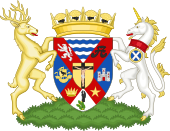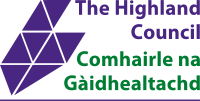|
Highland Council
The Highland Council (Comhairle na Gàidhealtachd Scottish Gaelic pronunciation: [ˈkʰõ.ərˠʎə nə ˈkɛːəl̪ˠt̪əxk]) is the local authority for Highland, one of the 32 council areas of Scotland. The council is based at the Highland Council Headquarters in Inverness. HistoryThe Highland area had been created as an administrative area in 1975 under the Local Government (Scotland) Act 1973, which established a two-tier structure of local government comprising upper-tier regions and lower-tier districts. Highland Regional Council was the upper-tier authority, and the region also contained eight districts, called Badenoch and Strathspey, Caithness, Inverness, Lochaber, Nairn, Ross and Cromarty, Skye and Lochalsh and Sutherland.[1] Further local government reform in 1996 under the Local Government etc. (Scotland) Act 1994 saw the area's districts and the regional council abolished, with a new unitary authority created covering the same area as the former Highland Region.[2] Until 2007, the new council maintained decentralised management and committee structures which related to former district boundaries. New management and committee structures, involving three corporate management areas and related committees, were created at the same time as the introduction of multi-member wards and single transferable vote elections in 2007. The 1995 election created a council of 72 members, each elected from a single-member ward by the first past the post system of election. Ward boundaries were redrawn for the 1999 election, to create 80 single-member wards and, again, election was by the first past the post system. The same wards and the same system of election were used for the 2003 election. For the 2007 election, ward boundaries were redrawn again, under the Local Governance (Scotland) Act 2004, to create the 22 multi-member wards, each electing three or four councillors by the single transferable vote system, but still electing a total of 80 councillors. For the 2017 election, the number of wards was reduced to 21, and the total number of councillors to 74. New ward boundaries were proposed by Boundaries Scotland in 2021 which would have reduced the total number of councillors to 73, however these were rejected by the Scottish Parliament.[3] The council has been a member of the Islands Forum since 2022. Political controlThe council has been under no overall control since 2007. Following the 2022 election the SNP formed the largest group with 22 councillors; this was the first time since the council's inception that independent councillors did not form the largest grouping. The SNP and some of the independent councillors subsequently formed a coalition to run the council.[4] The first election to the Highland Regional Council was held in 1974, initially operating as a shadow authority alongside the outgoing authorities until the new system came into force on 16 May 1975. A shadow authority was again elected in 1995 ahead of the reforms which came into force on 1 April 1996. Political control of the council since 1975 has been as follows:[5] Highland Regional Council
The Highland Council
LeadershipSince 2008, political leadership has been provided by the leader of the council.[6] The leaders since 2008 have been:[7]
CompositionFollowing the 2022 election and subsequent by-elections and changes of allegiance up to November 2024, the composition of the council was:[13]
Of the independent councillors, the majority form the 'Highland Independent' group which is in coalition with the SNP to form the council's administration. Some of the others form the 'Highland Alliance' while the rest sit as 'Non Aligned'. The next election is due in 2027.[14] PremisesThe council is based at the Highland Council Headquarters on Glenurquhart Road, in Inverness.[15] The oldest part of the building was originally a school, which was completed in 1876.[16] The complex was bought by the old Inverness-shire County Council in the 1930s and was significantly extended in the 1960s.[17] Inverness-shire County Council had held its meetings at Inverness Castle, but the council chamber there was too small to accommodate the Highland Regional Council created in 1975. The regional council therefore used the Glenurquhart Road building as its main offices, but initially held its meetings in the larger council chamber at the former Ross and Cromarty County Council's headquarters at County Buildings, Dingwall. A new council chamber was subsequently built at Glenurquhart Road in 1986.[18] The council also has numerous area offices.[19] Wards As of 2017, there are 21 wards, each of which is represented by 3 or 4 councillors. Ward forums are held by the councillors representing each ward: these meetings are open to the public.[20] A Ward Manager is appointed to each ward or group of wards.[21] Each ward receives a small discretionary budget that is managed by the ward manager.[20] The councillors representing groups of wards also sit as area committees, each covering areas which to some extent correspond with former local government boundaries. There are area committees for the counties of Caithness, Sutherland and Nairnshire, as well the city of Inverness. The remaining area committees cover Badenoch and Strathspey, the Black Isle, Dingwall and Seaforth, Easter Ross, Lochaber, the Isle of Skye and Raasay, and Wester Ross, Strathpeffer and Lochalsh.[22] List of wards:
For lists of historic wards and details of how they were grouped into corporate and ward management areas, see:
References
External links
|
|||||||||||||||||||||||||||||||||||||||||||||||||||||||||||||||||||||||||||||||||||||||||||||||||||||||||||||||||||||||||||||||||||||||||||||||||||||||||||||||||||||||||||||||||||||||


